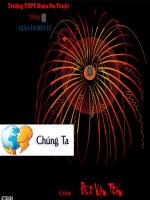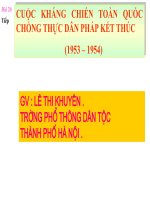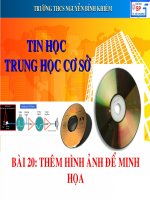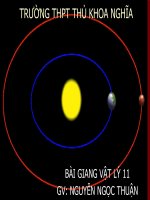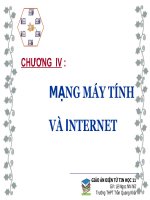bai 20
Bạn đang xem bản rút gọn của tài liệu. Xem và tải ngay bản đầy đủ của tài liệu tại đây (6.47 MB, 120 trang )
<span class='text_page_counter'>(1)</span>Chapter 20. Biotechnology. PowerPoint® Lecture Presentations for. Biology Eighth Edition Neil Campbell and Jane Reece Lectures by Chris Romero, updated by Erin Barley with contributions from Joan Sharp Copyright © 2008 Pearson Education, Inc., publishing as Pearson Benjamin Cummings.
<span class='text_page_counter'>(2)</span> Overview: The DNA Toolbox • Sequencing of the human genome was completed by 2007 • DNA sequencing has depended on advances in technology, starting with making recombinant DNA • In recombinant DNA, nucleotide sequences from two different sources, often two species, are combined in vitro into the same DNA molecule Copyright © 2008 Pearson Education Inc., publishing as Pearson Benjamin Cummings.
<span class='text_page_counter'>(3)</span> • Methods for making recombinant DNA are central to genetic engineering, the direct manipulation of genes for practical purposes • DNA technology has revolutionized biotechnology, the manipulation of organisms or their genetic components to make useful products • An example of DNA technology is the microarray, a measurement of gene expression of thousands of different genes Copyright © 2008 Pearson Education Inc., publishing as Pearson Benjamin Cummings.
<span class='text_page_counter'>(4)</span> Fig. 20-1.
<span class='text_page_counter'>(5)</span> Concept 20.1: DNA cloning yields multiple copies of a gene or other DNA segment • To work directly with specific genes, scientists prepare gene-sized pieces of DNA in identical copies, a process called DNA cloning. Copyright © 2008 Pearson Education Inc., publishing as Pearson Benjamin Cummings.
<span class='text_page_counter'>(6)</span> DNA Cloning and Its Applications: A Preview • Most methods for cloning pieces of DNA in the laboratory share general features, such as the use of bacteria and their plasmids • Plasmids are small circular DNA molecules that replicate separately from the bacterial chromosome • Cloned genes are useful for making copies of a particular gene and producing a protein product. Copyright © 2008 Pearson Education Inc., publishing as Pearson Benjamin Cummings.
<span class='text_page_counter'>(7)</span> • Gene cloning involves using bacteria to make multiple copies of a gene • Foreign DNA is inserted into a plasmid, and the recombinant plasmid is inserted into a bacterial cell • Reproduction in the bacterial cell results in cloning of the plasmid including the foreign DNA • This results in the production of multiple copies of a single gene Copyright © 2008 Pearson Education Inc., publishing as Pearson Benjamin Cummings.
<span class='text_page_counter'>(8)</span> Fig. 20-2 Bacterium 1 Gene inserted into plasmid. Bacterial Plasmid chromosome Recombinant DNA (plasmid). Cell containing gene of interest. Gene of interest. DNA of chromosome. 2 Plasmid put into bacterial cell. Recombinant bacterium 3 Host cell grown in culture to form a clone of cells containing the “cloned” gene of interest Gene of Interest. Protein expressed by gene of interest. Copies of gene. Basic. Protein harvested 4 Basic research and various applications. research on gene. Gene for pest resistance inserted into plants. Gene used to alter bacteria for cleaning up toxic waste. Protein dissolves blood clots in heart attack therapy. Basic research on protein. Human growth hormone treats stunted growth.
<span class='text_page_counter'>(9)</span> Fig. 20-2a. Bacterium 1 Gene inserted into. Cell containing gene of interest. plasmid. Bacterial chromosome. Plasmid Recombinant DNA (plasmid). Gene of interest 2. 2 Plasmid put into. bacterial cell. Recombinant bacterium. DNA of chromosome.
<span class='text_page_counter'>(10)</span> Fig. 20-2b. Recombinant bacterium 3 Host cell grown in culture. to form a clone of cells containing the “cloned” gene of interest. Protein expressed by gene of interest. Gene of Interest Copies of gene. Protein harvested 4 Basic research and. Basic research on gene. Gene for pest resistance inserted into plants. various applications. Gene used to alter bacteria for cleaning up toxic waste. Protein dissolves blood clots in heart attack therapy. Basic research on protein. Human growth hormone treats stunted growth.
<span class='text_page_counter'>(11)</span> Using Restriction Enzymes to Make Recombinant DNA • Bacterial restriction enzymes cut DNA molecules at specific DNA sequences called restriction sites • A restriction enzyme usually makes many cuts, yielding restriction fragments • The most useful restriction enzymes cut DNA in a staggered way, producing fragments with “sticky ends” that bond with complementary sticky ends of other fragments Animation: Restriction Enzymes Copyright © 2008 Pearson Education Inc., publishing as Pearson Benjamin Cummings.
<span class='text_page_counter'>(12)</span> • DNA ligase is an enzyme that seals the bonds between restriction fragments. Copyright © 2008 Pearson Education Inc., publishing as Pearson Benjamin Cummings.
<span class='text_page_counter'>(13)</span> Fig. 20-3-1. Restriction site DNA 1. 5 3. 3 5. Restriction enzyme cuts sugar-phosphate backbones.. Sticky end.
<span class='text_page_counter'>(14)</span> Fig. 20-3-2. Restriction site DNA 1. 5 3. 3 5. Restriction enzyme cuts sugar-phosphate backbones.. Sticky end. 2. DNA fragment added from another molecule cut by same enzyme. Base pairing occurs.. One possible combination.
<span class='text_page_counter'>(15)</span> Fig. 20-3-3. Restriction site DNA 1. 5 3. 3 5. Restriction enzyme cuts sugar-phosphate backbones.. Sticky end. 2. DNA fragment added from another molecule cut by same enzyme. Base pairing occurs.. One possible combination 3. DNA ligase seals strands.. Recombinant DNA molecule.
<span class='text_page_counter'>(16)</span> Cloning a Eukaryotic Gene in a Bacterial Plasmid • In gene cloning, the original plasmid is called a cloning vector • A cloning vector is a DNA molecule that can carry foreign DNA into a host cell and replicate there. Copyright © 2008 Pearson Education Inc., publishing as Pearson Benjamin Cummings.
<span class='text_page_counter'>(17)</span> Producing Clones of Cells Carrying Recombinant Plasmids • Several steps are required to clone the hummingbird β-globin gene in a bacterial plasmid: – The hummingbird genomic DNA and a bacterial plasmid are isolated – Both are digested with the same restriction enzyme – The fragments are mixed, and DNA ligase is added to bond the fragment sticky ends Animation: Cloning a Gene Copyright © 2008 Pearson Education Inc., publishing as Pearson Benjamin Cummings.
<span class='text_page_counter'>(18)</span> – Some recombinant plasmids now contain hummingbird DNA – The DNA mixture is added to bacteria that have been genetically engineered to accept it – The bacteria are plated on a type of agar that selects for the bacteria with recombinant plasmids – This results in the cloning of many hummingbird DNA fragments, including the β-globin gene Copyright © 2008 Pearson Education Inc., publishing as Pearson Benjamin Cummings.
<span class='text_page_counter'>(19)</span> Fig. 20-4-1 Hummingbird cell. TECHNIQUE Bacterial cell. ampR gene. lacZ gene. Bacterial plasmid. Restriction site. Sticky ends. Gene of interest Hummingbird DNA fragments.
<span class='text_page_counter'>(20)</span> Fig. 20-4-2 Hummingbird cell. TECHNIQUE Bacterial cell. ampR gene. lacZ gene. Bacterial plasmid. Restriction site. Sticky ends. Gene of interest Hummingbird DNA fragments Nonrecombinant plasmid. Recombinant plasmids.
<span class='text_page_counter'>(21)</span> Fig. 20-4-3 Hummingbird cell. TECHNIQUE Bacterial cell. ampR gene. lacZ gene. Bacterial plasmid. Restriction site. Sticky ends. Gene of interest Hummingbird DNA fragments Nonrecombinant plasmid. Recombinant plasmids. Bacteria carrying plasmids.
<span class='text_page_counter'>(22)</span> Fig. 20-4-4 Hummingbird cell. TECHNIQUE Bacterial cell. ampR gene. lacZ gene. Bacterial plasmid. Restriction site. Sticky ends. Gene of interest Hummingbird DNA fragments Nonrecombinant plasmid. Recombinant plasmids. Bacteria carrying plasmids. RESULTS Colony carrying nonrecombinant plasmid with intact lacZ gene. Colony carrying recombinant plasmid with disrupted lacZ gene One of many bacterial clones.
<span class='text_page_counter'>(23)</span> Storing Cloned Genes in DNA Libraries • A genomic library that is made using bacteria is the collection of recombinant vector clones produced by cloning DNA fragments from an entire genome • A genomic library that is made using bacteriophages is stored as a collection of phage clones. Copyright © 2008 Pearson Education Inc., publishing as Pearson Benjamin Cummings.
<span class='text_page_counter'>(24)</span> Fig. 20-5. Foreign genome cut up with restriction enzyme. Large insert Large plasmid with many genes. or BAC clone. Recombinant phage DNA Bacterial clones. (a) Plasmid library. Recombinant plasmids. (b) Phage library. Phage clones. (c) A library of bacterial artificial chromosome (BAC) clones.
<span class='text_page_counter'>(25)</span> Fig. 20-5a. Foreign genome cut up with restriction enzyme or Recombinant phage DNA Bacterial clones. (a) Plasmid library. Recombinant plasmids. (b) Phage library. Phage clones.
<span class='text_page_counter'>(26)</span> • A bacterial artificial chromosome (BAC) is a large plasmid that has been trimmed down and can carry a large DNA insert • BACs are another type of vector used in DNA library construction. Copyright © 2008 Pearson Education Inc., publishing as Pearson Benjamin Cummings.
<span class='text_page_counter'>(27)</span> Fig. 20-5b. Large plasmid. Large insert with many genes. BAC clone. (c) A library of bacterial artificial chromosome (BAC) clones.
<span class='text_page_counter'>(28)</span> • A complementary DNA (cDNA) library is made by cloning DNA made in vitro by reverse transcription of all the mRNA produced by a particular cell • A cDNA library represents only part of the genome—only the subset of genes transcribed into mRNA in the original cells. Copyright © 2008 Pearson Education Inc., publishing as Pearson Benjamin Cummings.
<span class='text_page_counter'>(29)</span> Fig. 20-6-1. DNA in nucleus mRNAs in cytoplasm.
<span class='text_page_counter'>(30)</span> Fig. 20-6-2. DNA in nucleus mRNAs in cytoplasm. mRNA. Reverse transcriptase Poly-A tail. DNA Primer strand.
<span class='text_page_counter'>(31)</span> Fig. 20-6-3. DNA in nucleus mRNAs in cytoplasm. mRNA. Reverse transcriptase Poly-A tail. Degraded mRNA. DNA Primer strand.
<span class='text_page_counter'>(32)</span> Fig. 20-6-4. DNA in nucleus mRNAs in cytoplasm. mRNA. Reverse transcriptase Poly-A tail. Degraded mRNA. DNA polymerase. DNA Primer strand.
<span class='text_page_counter'>(33)</span> Fig. 20-6-5. DNA in nucleus mRNAs in cytoplasm. mRNA. Reverse transcriptase Poly-A tail. DNA Primer strand. Degraded mRNA. DNA polymerase. cDNA.
<span class='text_page_counter'>(34)</span> Screening a Library for Clones Carrying a Gene of Interest • A clone carrying the gene of interest can be identified with a nucleic acid probe having a sequence complementary to the gene • This process is called nucleic acid hybridization. Copyright © 2008 Pearson Education Inc., publishing as Pearson Benjamin Cummings.
<span class='text_page_counter'>(35)</span> • A probe can be synthesized that is complementary to the gene of interest • For example, if the desired gene is 5 … G G C T AA C TT A G C … 3. – Then we would synthesize this probe 3 C C G A TT G A A T C G 5 Copyright © 2008 Pearson Education Inc., publishing as Pearson Benjamin Cummings.
<span class='text_page_counter'>(36)</span> • The DNA probe can be used to screen a large number of clones simultaneously for the gene of interest • Once identified, the clone carrying the gene of interest can be cultured. Copyright © 2008 Pearson Education Inc., publishing as Pearson Benjamin Cummings.
<span class='text_page_counter'>(37)</span> Fig. 20-7. TECHNIQUE Radioactively labeled probe molecules Multiwell plates holding library clones. Probe DNA. Gene of interest Single-stranded DNA from cell. Film. •. Nylon membrane Nylon Location of membrane DNA with the complementary sequence.
<span class='text_page_counter'>(38)</span> Expressing Cloned Eukaryotic Genes • After a gene has been cloned, its protein product can be produced in larger amounts for research • Cloned genes can be expressed as protein in either bacterial or eukaryotic cells. Copyright © 2008 Pearson Education Inc., publishing as Pearson Benjamin Cummings.
<span class='text_page_counter'>(39)</span> Bacterial Expression Systems • Several technical difficulties hinder expression of cloned eukaryotic genes in bacterial host cells • To overcome differences in promoters and other DNA control sequences, scientists usually employ an expression vector, a cloning vector that contains a highly active prokaryotic promoter. Copyright © 2008 Pearson Education Inc., publishing as Pearson Benjamin Cummings.
<span class='text_page_counter'>(40)</span> Eukaryotic Cloning and Expression Systems • The use of cultured eukaryotic cells as host cells and yeast artificial chromosomes (YACs) as vectors helps avoid gene expression problems • YACs behave normally in mitosis and can carry more DNA than a plasmid • Eukaryotic hosts can provide the posttranslational modifications that many proteins require Copyright © 2008 Pearson Education Inc., publishing as Pearson Benjamin Cummings.
<span class='text_page_counter'>(41)</span> • One method of introducing recombinant DNA into eukaryotic cells is electroporation, applying a brief electrical pulse to create temporary holes in plasma membranes • Alternatively, scientists can inject DNA into cells using microscopically thin needles • Once inside the cell, the DNA is incorporated into the cell’s DNA by natural genetic recombination Copyright © 2008 Pearson Education Inc., publishing as Pearson Benjamin Cummings.
<span class='text_page_counter'>(42)</span> Amplifying DNA in Vitro: The Polymerase Chain Reaction (PCR) • The polymerase chain reaction, PCR, can produce many copies of a specific target segment of DNA • A three-step cycle—heating, cooling, and replication—brings about a chain reaction that produces an exponentially growing population of identical DNA molecules. Copyright © 2008 Pearson Education Inc., publishing as Pearson Benjamin Cummings.
<span class='text_page_counter'>(43)</span> Fig. 20-8. 5. TECHNIQUE. 3 Target sequence. 3. Genomic DNA 1 Denaturation. 5. 5. 3. 3. 5. 2 Annealing Cycle 1 yields 2 molecules. Primers. 3 Extension New nucleotides. Cycle 2 yields 4 molecules. Cycle 3 yields 8 molecules; 2 molecules (in white boxes) match target sequence.
<span class='text_page_counter'>(44)</span> Fig. 20-8a. 5. TECHNIQUE. 3 Target sequence. Genomic DNA. 3. 5.
<span class='text_page_counter'>(45)</span> Fig. 20-8b. 1 Denaturation. 5. 3. 3. 5. 2 Annealing Cycle 1 yields 2 molecules. Primers. 3 Extension New nucleotides.
<span class='text_page_counter'>(46)</span> Fig. 20-8c. Cycle 2 yields 4 molecules.
<span class='text_page_counter'>(47)</span> Fig. 20-8d. Cycle 3 yields 8 molecules; 2 molecules (in white boxes) match target sequence.
<span class='text_page_counter'>(48)</span> Concept 20.2: DNA technology allows us to study the sequence, expression, and function of a gene • DNA cloning allows researchers to – Compare genes and alleles between individuals – Locate gene expression in a body – Determine the role of a gene in an organism. • Several techniques are used to analyze the DNA of genes. Copyright © 2008 Pearson Education Inc., publishing as Pearson Benjamin Cummings.
<span class='text_page_counter'>(49)</span> Gel Electrophoresis and Southern Blotting • One indirect method of rapidly analyzing and comparing genomes is gel electrophoresis • This technique uses a gel as a molecular sieve to separate nucleic acids or proteins by size • A current is applied that causes charged molecules to move through the gel • Molecules are sorted into “bands” by their size Video: Biotechnology Lab Copyright © 2008 Pearson Education Inc., publishing as Pearson Benjamin Cummings.
<span class='text_page_counter'>(50)</span> Fig. 20-9 TECHNIQUE Mixture of DNA molecules of different sizes. Power source – Cathode. Anode +. Gel. 1. Power source –. +. Longer molecules. 2. RESULTS. Shorter molecules.
<span class='text_page_counter'>(51)</span> Fig. 20-9a. TECHNIQUE Mixture of DNA molecules of different sizes. Power source Anode +. – Cathode. Gel. 1. Power source –. +. Longer molecules. 2. Shorter molecules.
<span class='text_page_counter'>(52)</span> Fig. 20-9b. RESULTS.
<span class='text_page_counter'>(53)</span> • In restriction fragment analysis, DNA fragments produced by restriction enzyme digestion of a DNA molecule are sorted by gel electrophoresis • Restriction fragment analysis is useful for comparing two different DNA molecules, such as two alleles for a gene • The procedure is also used to prepare pure samples of individual fragments Copyright © 2008 Pearson Education Inc., publishing as Pearson Benjamin Cummings.
<span class='text_page_counter'>(54)</span> Fig. 20-10. Normal -globin allele. 175 bp. DdeI. Sickle-cell allele. Large fragment. 201 bp. DdeI. Normal allele. DdeI. DdeI. Large fragment. Sickle-cell mutant -globin allele 376 bp. DdeI. 201 bp 175 bp. Large fragment. 376 bp. DdeI. DdeI. (a) DdeI restriction sites in normal and sickle-cell alleles of -globin gene. (b) Electrophoresis of restriction fragments from normal and sickle-cell alleles.
<span class='text_page_counter'>(55)</span> • A technique called Southern blotting combines gel electrophoresis of DNA fragments with nucleic acid hybridization • Specific DNA fragments can be identified by Southern blotting, using labeled probes that hybridize to the DNA immobilized on a “blot” of gel. Copyright © 2008 Pearson Education Inc., publishing as Pearson Benjamin Cummings.
<span class='text_page_counter'>(56)</span> Fig. 20-11 TECHNIQUE DNA + restriction enzyme. Restriction fragments. I. II. III. Heavy weight. Nitrocellulose membrane (blot) Gel Sponge. I Normal II Sickle-cell III Heterozygote -globin allele allele. 2 Gel electrophoresis. 1 Preparation of restriction fragments. Paper towels. Alkaline solution. 3 DNA transfer (blotting). Radioactively labeled probe for -globin gene. I. II. III. Probe base-pairs with fragments Fragment from sickle-cell -globin allele. Nitrocellulose blot. Fragment from normal -globin allele. 4 Hybridization with radioactive probe. I. II. III. Film over blot 5 Probe detection.
<span class='text_page_counter'>(57)</span> Fig. 20-11a. TECHNIQUE. DNA + restriction enzyme. Restriction fragments. I. II. III. Nitrocellulose membrane (blot). Heavy weight. Gel Sponge I Normal -globin allele. II Sickle-cell III Heterozygote allele. 1 Preparation of restriction fragments. Alkaline solution 2 Gel electrophoresis. Paper towels 3 DNA transfer (blotting).
<span class='text_page_counter'>(58)</span> Fig. 20-11b. Radioactively labeled probe for -globin gene. I. II III. Probe base-pairs with fragments Fragment from sickle-cell -globin allele. Fragment from normal -globin Nitrocellulose blot allele 4 Hybridization with radioactive probe. I. II. III. Film over blot 5 Probe detection.
<span class='text_page_counter'>(59)</span> DNA Sequencing • Relatively short DNA fragments can be sequenced by the dideoxy chain termination method • Modified nucleotides called dideoxyribonucleotides (ddNTP) attach to synthesized DNA strands of different lengths • Each type of ddNTP is tagged with a distinct fluorescent label that identifies the nucleotide at the end of each DNA fragment • The DNA sequence can be read from the resulting spectrogram Copyright © 2008 Pearson Education Inc., publishing as Pearson Benjamin Cummings.
<span class='text_page_counter'>(60)</span> Fig. 20-12 TECHNIQUE DNA (template strand). Primer. DNA polymerase. DNA (template strand). Deoxyribonucleotides dATP. ddATP. dCTP. ddCTP. dTTP. ddTTP. dGTP. ddGTP. Labeled strands. Shortest. Direction of movement of strands. Longest. Longest labeled strand Detector. Laser RESULTS. Shortest labeled strand Last base of longest labeled strand. Last base of shortest labeled strand. Dideoxyribonucleotides (fluorescently tagged).
<span class='text_page_counter'>(61)</span> Fig. 20-12a. TECHNIQUE DNA (template strand). Primer. DNA polymerase. Deoxyribonucleotides. Dideoxyribonucleotides (fluorescently tagged). dATP. ddATP. dCTP. ddCTP. dTTP. ddTTP. dGTP. ddGTP.
<span class='text_page_counter'>(62)</span> Fig. 20-12b. TECHNIQUE DNA (template strand). Labeled strands. Shortest. Direction of movement of strands. Longest. Longest labeled strand Detector. Laser RESULTS. Shortest labeled strand Last base of longest labeled strand. Last base of shortest labeled strand.
<span class='text_page_counter'>(63)</span> Analyzing Gene Expression • Nucleic acid probes can hybridize with mRNAs transcribed from a gene • Probes can be used to identify where or when a gene is transcribed in an organism. Copyright © 2008 Pearson Education Inc., publishing as Pearson Benjamin Cummings.
<span class='text_page_counter'>(64)</span> Studying the Expression of Single Genes • Changes in the expression of a gene during embryonic development can be tested using – Northern blotting – Reverse transcriptase-polymerase chain reaction. • Both methods are used to compare mRNA from different developmental stages. Copyright © 2008 Pearson Education Inc., publishing as Pearson Benjamin Cummings.
<span class='text_page_counter'>(65)</span> • Northern blotting combines gel electrophoresis of mRNA followed by hybridization with a probe on a membrane • Identification of mRNA at a particular developmental stage suggests protein function at that stage. Copyright © 2008 Pearson Education Inc., publishing as Pearson Benjamin Cummings.
<span class='text_page_counter'>(66)</span> • Reverse transcriptase-polymerase chain reaction (RT-PCR) is quicker and more sensitive • Reverse transcriptase is added to mRNA to make cDNA, which serves as a template for PCR amplification of the gene of interest • The products are run on a gel and the mRNA of interest identified. Copyright © 2008 Pearson Education Inc., publishing as Pearson Benjamin Cummings.
<span class='text_page_counter'>(67)</span> Fig. 20-13. TECHNIQUE 1 cDNA synthesis. mRNAs. cDNAs 2 PCR amplification. Primers. -globin gene 3 Gel electrophoresis RESULTS. Embryonic stages 1 2 3 4 5 6.
<span class='text_page_counter'>(68)</span> • In situ hybridization uses fluorescent dyes attached to probes to identify the location of specific mRNAs in place in the intact organism. Copyright © 2008 Pearson Education Inc., publishing as Pearson Benjamin Cummings.
<span class='text_page_counter'>(69)</span> Fig. 20-14. 50 µm.
<span class='text_page_counter'>(70)</span> Studying the Expression of Interacting Groups of Genes • Automation has allowed scientists to measure expression of thousands of genes at one time using DNA microarray assays • DNA microarray assays compare patterns of gene expression in different tissues, at different times, or under different conditions. Copyright © 2008 Pearson Education Inc., publishing as Pearson Benjamin Cummings.
<span class='text_page_counter'>(71)</span> Fig. 20-15. TECHNIQUE 1 Isolate mRNA.. 2 Make cDNA by reverse transcription, using fluorescently labeled nucleotides.. 3 Apply the cDNA mixture to a microarray, a different gene in each spot. The cDNA hybridizes with any complementary DNA on the microarray.. Tissue sample. mRNA molecules. Labeled cDNA molecules (single strands) DNA fragments representing specific genes. DNA microarray 4 Rinse off excess cDNA; scan microarray for fluorescence. Each fluorescent spot represents a gene expressed in the tissue sample.. DNA microarray with 2,400 human genes.
<span class='text_page_counter'>(72)</span> Determining Gene Function • One way to determine function is to disable the gene and observe the consequences • Using in vitro mutagenesis, mutations are introduced into a cloned gene, altering or destroying its function • When the mutated gene is returned to the cell, the normal gene’s function might be determined by examining the mutant’s phenotype Copyright © 2008 Pearson Education Inc., publishing as Pearson Benjamin Cummings.
<span class='text_page_counter'>(73)</span> • Gene expression can also be silenced using RNA interference (RNAi) • Synthetic double-stranded RNA molecules matching the sequence of a particular gene are used to break down or block the gene’s mRNA. Copyright © 2008 Pearson Education Inc., publishing as Pearson Benjamin Cummings.
<span class='text_page_counter'>(74)</span> Concept 20.3: Cloning organisms may lead to production of stem cells for research and other applications • Organismal cloning produces one or more organisms genetically identical to the “parent” that donated the single cell. Copyright © 2008 Pearson Education Inc., publishing as Pearson Benjamin Cummings.
<span class='text_page_counter'>(75)</span> Cloning Plants: Single-Cell Cultures • One experimental approach for testing genomic equivalence is to see whether a differentiated cell can generate a whole organism • A totipotent cell is one that can generate a complete new organism. Copyright © 2008 Pearson Education Inc., publishing as Pearson Benjamin Cummings.
<span class='text_page_counter'>(76)</span> Fig. 20-16. EXPERIMENT. RESULTS Transverse section of carrot root. 2-mg fragments. Fragments were cultured in nutrient medium; stirring caused single cells to shear off into the liquid.. Single cells free in suspension began to divide.. Embryonic plant developed from a cultured single cell.. Plantlet was cultured on agar medium. Later it was planted in soil.. A single somatic carrot cell developed into a mature carrot plant..
<span class='text_page_counter'>(77)</span> Cloning Animals: Nuclear Transplantation • In nuclear transplantation, the nucleus of an unfertilized egg cell or zygote is replaced with the nucleus of a differentiated cell • Experiments with frog embryos have shown that a transplanted nucleus can often support normal development of the egg • However, the older the donor nucleus, the lower the percentage of normally developing tadpoles Copyright © 2008 Pearson Education Inc., publishing as Pearson Benjamin Cummings.
<span class='text_page_counter'>(78)</span> Fig. 20-17. EXPERIMENT. Frog egg cell Frog tadpole. Frog embryo UV. Less differentiated cell. Fully differentiated (intestinal) cell. Donor nucleus transplanted. Donor nucleus transplanted. Enucleated egg cell Egg with donor nucleus activated to begin development. RESULTS. Most develop into tadpoles. Most stop developing before tadpole stage.
<span class='text_page_counter'>(79)</span> Reproductive Cloning of Mammals • In 1997, Scottish researchers announced the birth of Dolly, a lamb cloned from an adult sheep by nuclear transplantation from a differentiated mammary cell • Dolly’s premature death in 2003, as well as her arthritis, led to speculation that her cells were not as healthy as those of a normal sheep, possibly reflecting incomplete reprogramming of the original transplanted nucleus. Copyright © 2008 Pearson Education Inc., publishing as Pearson Benjamin Cummings.
<span class='text_page_counter'>(80)</span> Fig. 20-18. TECHNIQUE Mammary cell donor. Egg cell donor 2. 1. Egg cell from ovary 3 Cells fused Cultured mammary cells 3. 4 Grown in. Nucleus removed. Nucleus from mammary cell. culture. Early embryo 5 Implanted. in uterus of a third sheep. Surrogate mother. 6 Embryonic. development. RESULTS. Lamb (“Dolly”) genetically identical to mammary cell donor.
<span class='text_page_counter'>(81)</span> • Since 1997, cloning has been demonstrated in many mammals, including mice, cats, cows, horses, mules, pigs, and dogs • CC (for Carbon Copy) was the first cat cloned; however, CC differed somewhat from her female “parent”. Copyright © 2008 Pearson Education Inc., publishing as Pearson Benjamin Cummings.
<span class='text_page_counter'>(82)</span> Fig. 20-19.
<span class='text_page_counter'>(83)</span> Problems Associated with Animal Cloning • In most nuclear transplantation studies, only a small percentage of cloned embryos have developed normally to birth • Many epigenetic changes, such as acetylation of histones or methylation of DNA, must be reversed in the nucleus from a donor animal in order for genes to be expressed or repressed appropriately for early stages of development. Copyright © 2008 Pearson Education Inc., publishing as Pearson Benjamin Cummings.
<span class='text_page_counter'>(84)</span> Stem Cells of Animals • A stem cell is a relatively unspecialized cell that can reproduce itself indefinitely and differentiate into specialized cells of one or more types • Stem cells isolated from early embryos at the blastocyst stage are called embryonic stem cells; these are able to differentiate into all cell types • The adult body also has stem cells, which replace nonreproducing specialized cells Copyright © 2008 Pearson Education Inc., publishing as Pearson Benjamin Cummings.
<span class='text_page_counter'>(85)</span> Fig. 20-20 Embryonic stem cells. Adult stem cells. Early human embryo at blastocyst stage (mammalian equivalent of blastula). From bone marrow in this example. Cells generating all embryonic cell types. Cells generating some cell types. Cultured stem cells. Different culture conditions. Different types of differentiated cells. Liver cells. Nerve cells. Blood cells.
<span class='text_page_counter'>(86)</span> • The aim of stem cell research is to supply cells for the repair of damaged or diseased organs. Copyright © 2008 Pearson Education Inc., publishing as Pearson Benjamin Cummings.
<span class='text_page_counter'>(87)</span> Concept 20.4: The practical applications of DNA technology affect our lives in many ways • Many fields benefit from DNA technology and genetic engineering. Copyright © 2008 Pearson Education Inc., publishing as Pearson Benjamin Cummings.
<span class='text_page_counter'>(88)</span> Medical Applications • One benefit of DNA technology is identification of human genes in which mutation plays a role in genetic diseases. Copyright © 2008 Pearson Education Inc., publishing as Pearson Benjamin Cummings.
<span class='text_page_counter'>(89)</span> Diagnosis of Diseases • Scientists can diagnose many human genetic disorders by using PCR and primers corresponding to cloned disease genes, then sequencing the amplified product to look for the disease-causing mutation • Genetic disorders can also be tested for using genetic markers that are linked to the diseasecausing allele. Copyright © 2008 Pearson Education Inc., publishing as Pearson Benjamin Cummings.
<span class='text_page_counter'>(90)</span> • Single nucleotide polymorphisms (SNPs) are useful genetic markers • These are single base-pair sites that vary in a population • When a restriction enzyme is added, SNPs result in DNA fragments with different lengths, or restriction fragment length polymorphism (RFLP). Copyright © 2008 Pearson Education Inc., publishing as Pearson Benjamin Cummings.
<span class='text_page_counter'>(91)</span> Fig. 20-21. DNA T Normal allele SNP C Disease-causing allele.
<span class='text_page_counter'>(92)</span> Human Gene Therapy • Gene therapy is the alteration of an afflicted individual’s genes • Gene therapy holds great potential for treating disorders traceable to a single defective gene • Vectors are used for delivery of genes into specific types of cells, for example bone marrow • Gene therapy raises ethical questions, such as whether human germ-line cells should be treated to correct the defect in future generations Copyright © 2008 Pearson Education Inc., publishing as Pearson Benjamin Cummings.
<span class='text_page_counter'>(93)</span> Fig. 20-22. Cloned gene. 1. Insert RNA version of normal allele into retrovirus.. Viral RNA 2. Retrovirus capsid. Let retrovirus infect bone marrow cells that have been removed from the patient and cultured. 3. Viral DNA carrying the normal allele inserts into chromosome.. Bone marrow cell from patient. 4. Inject engineered cells into patient.. Bone marrow.
<span class='text_page_counter'>(94)</span> Pharmaceutical Products • Advances in DNA technology and genetic research are important to the development of new drugs to treat diseases. Copyright © 2008 Pearson Education Inc., publishing as Pearson Benjamin Cummings.
<span class='text_page_counter'>(95)</span> Synthesis of Small Molecules for Use as Drugs • The drug imatinib is a small molecule that inhibits overexpression of a specific leukemiacausing receptor • Pharmaceutical products that are proteins can be synthesized on a large scale. Copyright © 2008 Pearson Education Inc., publishing as Pearson Benjamin Cummings.
<span class='text_page_counter'>(96)</span> Protein Production in Cell Cultures • Host cells in culture can be engineered to secrete a protein as it is made • This is useful for the production of insulin, human growth hormones, and vaccines. Copyright © 2008 Pearson Education Inc., publishing as Pearson Benjamin Cummings.
<span class='text_page_counter'>(97)</span> Protein Production by “Pharm” Animals and Plants • Transgenic animals are made by introducing genes from one species into the genome of another animal • Transgenic animals are pharmaceutical “factories,” producers of large amounts of otherwise rare substances for medical use • “Pharm” plants are also being developed to make human proteins for medical use Copyright © 2008 Pearson Education Inc., publishing as Pearson Benjamin Cummings.
<span class='text_page_counter'>(98)</span> Fig. 20-23.
<span class='text_page_counter'>(99)</span> Fig. 20-23a.
<span class='text_page_counter'>(100)</span> Fig. 20-23b.
<span class='text_page_counter'>(101)</span> Forensic Evidence and Genetic Profiles • An individual’s unique DNA sequence, or genetic profile, can be obtained by analysis of tissue or body fluids • Genetic profiles can be used to provide evidence in criminal and paternity cases and to identify human remains • Genetic profiles can be analyzed using RFLP analysis by Southern blotting. Copyright © 2008 Pearson Education Inc., publishing as Pearson Benjamin Cummings.
<span class='text_page_counter'>(102)</span> • Even more sensitive is the use of genetic markers called short tandem repeats (STRs), which are variations in the number of repeats of specific DNA sequences • PCR and gel electrophoresis are used to amplify and then identify STRs of different lengths • The probability that two people who are not identical twins have the same STR markers is exceptionally small Copyright © 2008 Pearson Education Inc., publishing as Pearson Benjamin Cummings.
<span class='text_page_counter'>(103)</span> Fig. 20-24. (a) This photo shows Earl Washington just before his release in 2001, after 17 years in prison.. Source of sample. STR marker 1. STR marker 2. STR marker 3. Semen on victim. 17, 19. 13, 16. 12, 12. Earl Washington. 16, 18. 14, 15. 11, 12. Kenneth Tinsley. 17, 19. 13, 16. 12, 12. (b) These and other STR data exonerated Washington and led Tinsley to plead guilty to the murder..
<span class='text_page_counter'>(104)</span> Environmental Cleanup • Genetic engineering can be used to modify the metabolism of microorganisms • Some modified microorganisms can be used to extract minerals from the environment or degrade potentially toxic waste materials • Biofuels make use of crops such as corn, soybeans, and cassava to replace fossil fuels. Copyright © 2008 Pearson Education Inc., publishing as Pearson Benjamin Cummings.
<span class='text_page_counter'>(105)</span> Agricultural Applications • DNA technology is being used to improve agricultural productivity and food quality. Copyright © 2008 Pearson Education Inc., publishing as Pearson Benjamin Cummings.
<span class='text_page_counter'>(106)</span> Animal Husbandry • Genetic engineering of transgenic animals speeds up the selective breeding process • Beneficial genes can be transferred between varieties or species. Copyright © 2008 Pearson Education Inc., publishing as Pearson Benjamin Cummings.
<span class='text_page_counter'>(107)</span> Genetic Engineering in Plants • Agricultural scientists have endowed a number of crop plants with genes for desirable traits • The Ti plasmid is the most commonly used vector for introducing new genes into plant cells • Genetic engineering in plants has been used to transfer many useful genes including those for herbicide resistance, increased resistance to pests, increased resistance to salinity, and improved nutritional value of crops Copyright © 2008 Pearson Education Inc., publishing as Pearson Benjamin Cummings.
<span class='text_page_counter'>(108)</span> Fig. 20-25. TECHNIQUE Agrobacterium tumefaciens. Ti plasmid Site where restriction enzyme cuts T DNA DNA with the gene of interest. RESULTS. Recombinant Ti plasmid. Plant with new trait.
<span class='text_page_counter'>(109)</span> Safety and Ethical Questions Raised by DNA Technology • Potential benefits of genetic engineering must be weighed against potential hazards of creating harmful products or procedures • Guidelines are in place in the United States and other countries to ensure safe practices for recombinant DNA technology. Copyright © 2008 Pearson Education Inc., publishing as Pearson Benjamin Cummings.
<span class='text_page_counter'>(110)</span> • Most public concern about possible hazards centers on genetically modified (GM) organisms used as food • Some are concerned about the creation of “super weeds” from the transfer of genes from GM crops to their wild relatives. Copyright © 2008 Pearson Education Inc., publishing as Pearson Benjamin Cummings.
<span class='text_page_counter'>(111)</span> • As biotechnology continues to change, so does its use in agriculture, industry, and medicine • National agencies and international organizations strive to set guidelines for safe and ethical practices in the use of biotechnology. Copyright © 2008 Pearson Education Inc., publishing as Pearson Benjamin Cummings.
<span class='text_page_counter'>(112)</span> Fig. 20-UN3. Vector. DNA fragments from genomic DNA or cDNA or copy of DNA obtained by PCR. Cut by same restriction enzyme, mixed, and ligated. Recombinant DNA plasmids.
<span class='text_page_counter'>(113)</span> Fig. 20-UN4. 5 3. TCCATGAATTCTAAAGCGCTTATGAATTCACGGC AGGTACTTAAGATTTCGCGAATACTTAAGTGCCG Aardvark DNA GAATT C T TA A C G. Plasmid. 3 5.
<span class='text_page_counter'>(114)</span> Fig. 20-UN5.
<span class='text_page_counter'>(115)</span> Fig. 20-UN6.
<span class='text_page_counter'>(116)</span> Fig. 20-UN7.
<span class='text_page_counter'>(117)</span> You should now be able to: 1. Describe the natural function of restriction enzymes and explain how they are used in recombinant DNA technology 2. Outline the procedures for cloning a eukaryotic gene in a bacterial plasmid 3. Define and distinguish between genomic libraries using plasmids, phages, and cDNA 4. Describe the polymerase chain reaction (PCR) and explain the advantages and limitations of this procedure Copyright © 2008 Pearson Education Inc., publishing as Pearson Benjamin Cummings.
<span class='text_page_counter'>(118)</span> 5. Explain how gel electrophoresis is used to analyze nucleic acids and to distinguish between two alleles of a gene 6. Describe and distinguish between the Southern blotting procedure, Northern blotting procedure, and RT-PCR 7. Distinguish between gene cloning, cell cloning, and organismal cloning 8. Describe how nuclear transplantation was used to produce Dolly, the first cloned sheep Copyright © 2008 Pearson Education Inc., publishing as Pearson Benjamin Cummings.
<span class='text_page_counter'>(119)</span> 9. Describe the application of DNA technology to the diagnosis of genetic disease, the development of gene therapy, vaccine production, and the development of pharmaceutical products 10.Define a SNP and explain how it may produce a RFLP 11.Explain how DNA technology is used in the forensic sciences Copyright © 2008 Pearson Education Inc., publishing as Pearson Benjamin Cummings.
<span class='text_page_counter'>(120)</span> 12.Discuss the safety and ethical questions related to recombinant DNA studies and the biotechnology industry. Copyright © 2008 Pearson Education Inc., publishing as Pearson Benjamin Cummings.
<span class='text_page_counter'>(121)</span>

